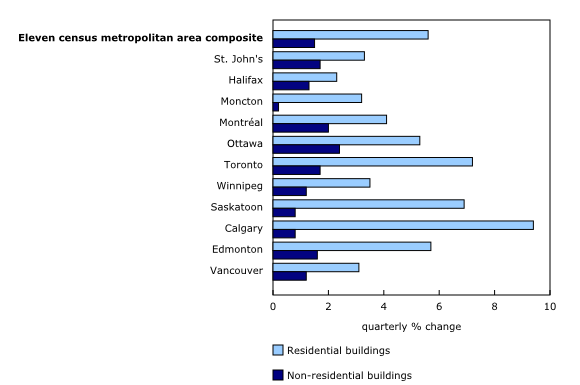Building construction price indexes, first quarter 2021
Archived Content
Information identified as archived is provided for reference, research or recordkeeping purposes. It is not subject to the Government of Canada Web Standards and has not been altered or updated since it was archived. Please "contact us" to request a format other than those available.
Released: 2021-05-06
Prices for residential building construction increased 5.6% in the first quarter—the largest increase since the data series began in 2017. Non-residential building construction prices rose 1.5%, led mostly by higher construction costs for factories and warehouses.
Construction costs rise during the first quarter
Construction costs were up for every building type in the first quarter, ranging from a 1.2% increase for office buildings, to a 6.9% gain for townhouses, followed closely by single-detached houses (+6.8%).
Higher construction costs overall were mostly attributable to a shortage of construction materials, which led to higher month-over-month prices for softwood lumber (+11.9%) and veneer and plywood (+20.1%) in March. Softwood lumber (+118.9%) prices rose at their fastest year-over-year pace on record in March, partially because of low stocks following the temporary shutdown of sawmills during the first wave of the COVID-19 pandemic. The demand for materials continued to be high as building materials and supplies sold by wholesalers were up 19.1% year over year in February.
The surge in residential construction costs was also spurred by historically low interest rates and a desire for more living space during the pandemic. Investment in residential construction continued to rise, mostly driven by the growth of single-family home construction. Residential construction investments have been reaching consecutive record levels since September 2020 and stood at a new high of $12.3 billion in February.
In Toronto, residential construction costs were up 7.2% overall, led by a 9.0% price increase to build single-detached houses.
Non-residential building construction costs rose at the fastest pace for factories (+2.1%) and warehouses (+1.8%) in the first quarter. Warehouse space is at a premium in the wake of retail e-commerce sales increasing 92.0% year over year in February, following a 116.8% surge in January.
Non-residential building costs were up in every city covered by the survey, with prices rising at the fastest pace in Ottawa (+2.4%) and Montréal (+2.0%), mostly because of warehouses and factories.
Construction costs increase the most in Calgary, Toronto and Ottawa year over year
Residential building (+11.7%) construction costs rose at a record year-over-year pace in the first quarter, mostly because of limited supply and increased demand for building materials.
Construction costs for a single-detached house accelerated from a 4.4% year-over-year increase in the third quarter of 2020 to a 14.6% rise in the first quarter of 2021.
Residential building construction costs rose at the fastest pace in Calgary (+16.8%), Toronto (+15.0%) and Ottawa (+14.6%) in the first quarter.
Non-residential building construction costs rose 2.1% year over year, led by Ottawa (+4.9%) and Montréal (+4.4%), mostly because of factories.
Note to readers
The building construction price indexes are quarterly series that measure the change over time in the prices that contractors charge to construct a range of commercial, institutional, industrial and residential buildings in 11 census metropolitan areas: St. John's, Halifax, Moncton, Montréal, Ottawa–Gatineau (Ontario part), Toronto, Winnipeg, Saskatoon, Calgary, Edmonton and Vancouver.
These buildings include six non-residential structures: an office building, a warehouse, a shopping centre, a factory, a school, and a bus depot with maintenance and repair facilities. In addition, indexes are produced for five residential structures: a bungalow, a two-storey house, a townhouse, a high-rise apartment building (five storeys or more) and a low-rise apartment building (fewer than five storeys).
The contractor's price reflects the value of all materials, labour, equipment, overhead and profit to construct a new building. It excludes value-added taxes and any costs for land, land assembly, building design, land development and real estate fees.
With each release, data for the previous quarter may have been revised. The index is not seasonally adjusted.
Products
Statistics Canada has launched the Producer price indexes portal as part of a suite of portals for prices and price indexes. This web page provides Canadians with a single point of access to a wide variety of statistics and measures related to producer prices.
The video "Producer Price Indexes" is available on the Statistics Canada Training Institute webpage. It provides an introduction to Statistics Canada's producer price indexes—what they are, how they are made and what they are used for.
Contact information
For more information, or to enquire about the concepts, methods or data quality of this release, contact us (toll-free 1-800-263-1136; 514-283-8300; STATCAN.infostats-infostats.STATCAN@canada.ca) or Media Relations (613-951-4636; STATCAN.mediahotline-ligneinfomedias.STATCAN@canada.ca).
- Date modified:



